Sand Fluffer |
||
Work
|
A sand fluffer is a device that is used to aerate, break up and recondition the sand after casting, and do the initial mixing to get the sand ready for casting. There are several reasons to consider building your own sand fluffer. In order to prepare the sand for casting it is necessary to mix it some way. If you're using green sand it would be possible to mix by hand but it would be a lot of work, especially considering how little, in time and costs, it takes to build a sand fluffer. If you use an oil base sand, such as petrobond, it is my understanding that you need to use a sand muller to initially prepare it. Once the petrobond is prepared it is possible to get by without a muller for a while using only the sand fluffer to recondition the sand after a casting session. If you are using green sand the sand fluffer is all you should need, it will even make the initial preparation of your sand much easier. You can click on any of the pictures below to see a more detailed picture, use the back button in your browser to return to this page. The design of the sand fluffer I use is based on the fluffer described in Stewart Marshalls' CD Building Small Cupola Furnaces - The CD. The first fluffer pictured below is of this type as built by Bob McDonald. This is essentially straight from Stewart's CD. The next one is Rupert Wenig's fluffer. He changed the design of the fluffer so that the motor is underneath, this makes the unit much more compact and easier to move around. He also tried using expanded metal instead of a series of metal pins around the disk. He found that it worked with green sand but if he used petrobond the sand would tend to stick and throw the unit out of balance. This necessitated stopping and taking the offending lump of sand out by hand. 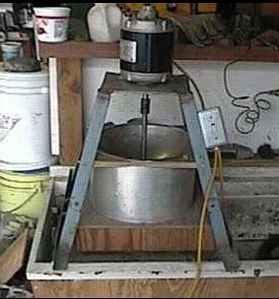
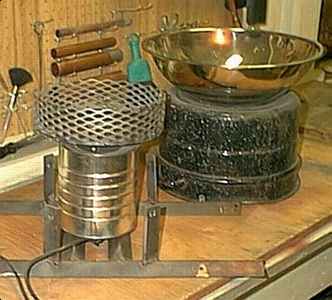
I elected to go with this design, although I decided to use larger expanded metal so that, hopefully, I wouldn't have the problem with sand sticking. So far I have used it to initially prepare my green sand and to recondition it after casting aluminum. I haven't had problems with sand sticking yet, although it may be possible that problems may arise if I start using petrobond or casting a higher temp metal that may bake the sand harder. 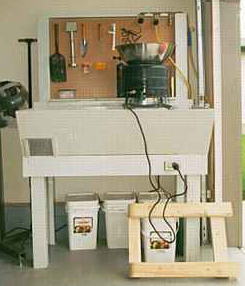
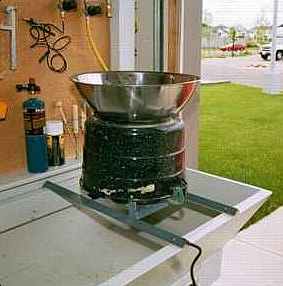
Above is a picture of my sand fluffer sitting on my molding bench. In the picture you can also see the switched plug I installed in the bench specifically for the fluffer. This way the switch and cord are convenient in case it goes out of balance and you want to stop it but allows the cord to stay out of my way when I'm working. The next picture is a closer look at my sand fluffer. The main support pieces that the whole thing is resting on are 1 1/4" X 1/8" angle iron set to form an upside down "V". This helps keep the sand from collecting on top of them during use. The "funnel" on top is a cheap stainless steel bowl and the black cover is a garage sale special canner. I ran the power supply cord under one of the angle iron pieces so it would not get in the way in use. When you shovel the sand in the top it goes through the fluffer and winds up in the bench. This works well, I simply pile the sand to one side of my molding bench and then feed it through the fluffer. If I need to go through more than once I slide the fluffer over to the other side and repeat. 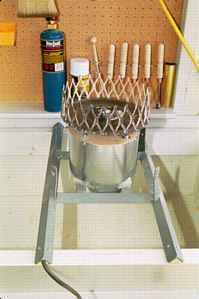
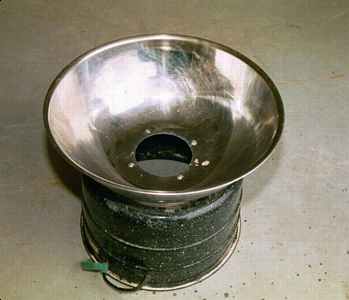
Above is my fluffer with the outside housing removed. The cover on the motor is a disc of 3/8" mdf on top with a cylinder of galvanized sheet metal around it. I simply drilled a hole in the centre of the mdf disc that was a snug fit on the motor shaft and I have not had any problems as of yet with sand getting into the motor. The spinning disc is a 9" diameter roller chain gear that I had handy. I was able to make it fit the motor shaft with the use of a bushing. I welded a ring of 2.5" high expanded metal around the circumference of the disc. The motor is an old washing machine motor. Make sure that the motor you use is 1725 rpm and not 3450 otherwise you'll have sand everywhere. The motor I'm using is 3/4 hp, thanks to Robert Grauman, but others in the group are using 1/2 hp motors and they are working well. The second picture above is the outer housing and funnel of my fluffer. I simply riveted the stainless bowl and canner together. 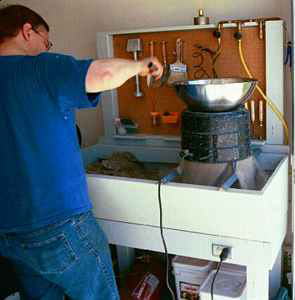
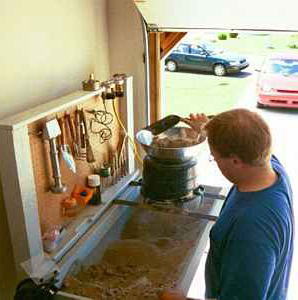
These pictures show me making use of my sand fluffer, you can see the sand coming out from underneath the fluffer. You can see how I'm working the sand from the left, where it's full of lumps after casting, to the right, where it's broken up again. Once the sand has all been through the fluffer I can just slide the fluffer to the left and repeat the process if it is necessary. |
|
|
|